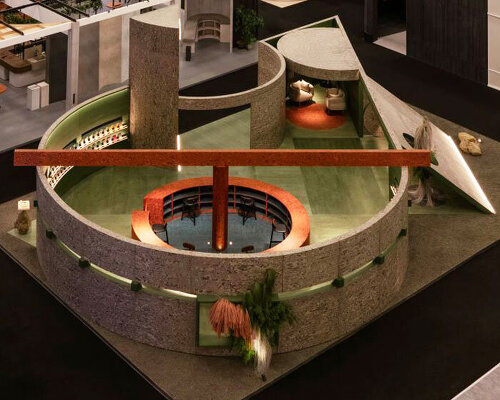Openness and restraint define Timber Pavilion by ISSO Architects
ISSO Architects designed A Nest in the Tree for MUKA’s exhibition at IndoBuildTech 2025, Indonesia’s largest architecture and interior design fair. Occupying an 11-by-17-meter plot, the project rethinks the conventional trade fair booth, prioritizing openness and spatial clarity within the visually dense exhibition environment.
While exhibition halls often favor maximum density, A Nest in the Tree introduces restraint as a design strategy. By stepping back from the aisle and allowing the space to breathe, the booth establishes a clear threshold, inviting visitors to experience it as a unified spatial composition before entering. The layout follows a simple program, a single counter for welcoming guests, and a gallery for displaying MUKA’s wooden veneer products. The design draws conceptual and material inspiration from the process of veneer making, where thin layers are peeled from solid timber. Similarly, the booth is formed through an approach of carving and hollowing, subtracting and opening volumes within a solid mass. This operation produces a sequence of interconnected spaces for gathering, viewing, and rest.
all images courtesy of ISSO Architects
A Nest in the Tree features network of voids and framed openings
From the exterior, the booth appears as a grounded timber structure, but its interior reveals a network of voids and framed openings that encourage movement and visual exploration. Narrow slits along the facade allow glimpses of the interior, establishing a subtle boundary between privacy and display. For studio ISSO Architects, color and materiality play a central role. Departing from the natural tones typically associated with wood, the design showcases MUKA’s distinctive veneer colors through a layered chromatic experience. A muted grey facade opens to a vivid red central counter and a surrounding green wall. This gradient highlights the range of veneer textures and finishes while guiding visitors through distinct zones of the installation.
Each spatial element, like the veranda, foyer, nook, and courtyard, serves a specific function within the compact footprint. Together, they define a small architectural system that balances openness with enclosure. The result is a booth that functions both as a display environment and a temporary architectural installation, demonstrating how material experimentation and spatial restraint can transform exhibition design into a cohesive architectural experience.
ISSO Architects designs A Nest in the Tree for MUKA at IndoBuildTech 2025
the booth reinterprets exhibition design through openness and restraint
a setback from the aisle allows the space to breathe within a crowded hall
inspired by the process of veneer making, the booth emerges through carving and subtraction
the layout centers on a single counter and a veneer display gallery
the structure evokes layers peeled from timber, transforming solid mass into space
interconnected voids form zones for gathering, pause, and display
the exterior presents a grounded timber volume within the exhibition hall
inside, voids and framed openings invite gradual exploration
color and material define the spatial rhythm of the installation
the design balances visibility and enclosure through controlled openings
narrow facade slits reveal glimpses of interior activity
a muted grey facade opens to a vivid red counter at the core
veneer surfaces highlight texture, color, and light variation
project info:
name: A Nest in the Tree
designer: ISSO Architects | @issoarchitects
lead architects: Wibisono Soegih, Stephanie Tatimu
design team: Rangga Cakra Birawa, Arini Zairina Putri, Nabila Rachmasari Putri
location: ICE BSD City, Indonesia
host: IndoBuildTech 2025
brand: MUKA | @muka_surface
designboom has received this project from our DIY submissions feature, where we welcome our readers to submit their own work for publication. see more project submissions from our readers here.
edited by: christina vergopoulou | designboom
The post circular timber pavilion with voids and slits displays variety of veneer textures and finishes appeared first on designboom | architecture & design magazine.

